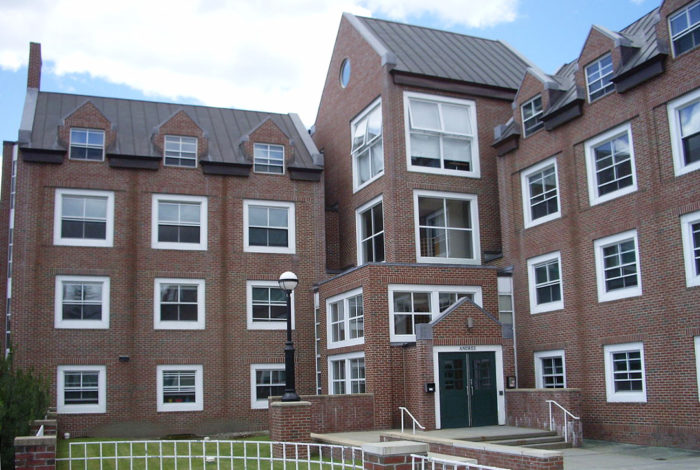
Image Credit: Image #1: Wikimedia Commons. Photo of oil lamps: Patricia Appelbaum. All other photos: Martin Holladay.
The design of brick buildings and the quality of brick construction have declined dramatically in the last 100 years. While this statement is debatable, I’ll try to defend it with evidence. If my evidence is compelling, it raises questions about why certain technologies advance in sophistication while other technologies decline.
Before I return to the topic of brick buildings, I’d like to take a detour to look at an example of technological evolution.
I’m going to look at lighting technology — but I’m going to dial the time machine back before LEDs, before compact fluorescents, and before the incandescent lamp. I’m going to look at the evolution of the common household lamp: specifically, Palestinian olive oil lamps that were used between 2,500 B.C. and the 11th century A.D.
My father, William Holladay, is now retired. He spent most of his working years as a full-time professor of Old Testament studies, with a specialty in the book of Jeremiah. He also worked (occasionally) as a part-time archaeologist. During the 1960s, when my family lived in Beirut, Lebanon, my father acquired a collection of ancient oil lamps. Most of these lamps were purchased in Jordan in 1964, when my father worked at a dig in Shechem.
When arranged chronologically, the lamps tell a story of technological evolution. The earliest lamp in the collection, the one that dates from 2,500 B.C., is a simple bowl. It worked, but it was far from a perfect tool. If you tried to carry this lamp, the wick could easily slip from the bowl, creating a fire hazard, and precious oil could be easily spilled.
Potters eventually learned to pinch one side of the bowl to create a recess for the wick, making it less likely that the wick would fall to the floor…
Weekly Newsletter
Get building science and energy efficiency advice, plus special offers, in your inbox.

This article is only available to GBA Prime Members
Sign up for a free trial and get instant access to this article as well as GBA’s complete library of premium articles and construction details.
Start Free TrialAlready a member? Log in













16 Comments
which came first: the architecture or the brick?
In the bank building, the brick and the architecture are interdependent. That kind of architecture can only be executed in brick, and the brick in turn makes the architecture possible.
In the dorm, the brick is incidental to the architecture -- that building could have gotten almost any cladding and it would not have mattered much to the architecture. What it got was tantamount to wallpaper printed with a brick pattern. It's curtain-wall brick. It's just there to provide a color and texture that panders to what people think a New England college dorm should have for cladding.
If your brick cladding is functioning primarily as wallpaper, it's hard to care about getting the details right.
Response to Paul Eldrenkamp
Paul,
Thanks for your comments. I agree that architects these days often think of "cladding" as a last-minute decision, like choosing an outfit to wear to a party -- as if you could dress a building in any one of a variety of costumes.
On some level, this approach -- "Which cladding shall we choose?" -- might work, but only if the architect cares about water-management details. It doesn't matter to me whether the architect prefers stucco, vinyl siding, cedar shingles, or brick veneer -- but you still have to learn how to keep the water out...
Stains where water dribbles
Stains where water dribbles down facades is ubiquitous in modern masonry buildings - so is it an all too frequent design flaw? Perhaps it's an intentional design statement (although I can't imagine what they are saying).
Response to Bob Irving
Bob,
The phrase "an intentional design statement" seems to me to be a particularly charitable explanation for these ubiquitous examples of architects' ignorance and incompetence.
For more examples of egregious dribbling, see Brick Buildings Need Roof Overhangs.
Bank caption typo
Typo: The caption "A building from the 1980s" under the bank building should read "A building from the 1890s".
Response to Adam Liberman
Adam,
The phrase you quote -- "A building from the 1980s" -- is a heading to introduce the paragraphs that follow. It is not a photo caption. I'll see what I can do to clarify the amgibuity.
Cost
I would guess that the relative cost of building a brick building has gone up (compared with other alternatives). So while Dartmouth may have the money, I would think the demand for high quality masons that would have been high in the 1890s (when there were fewer alternatives), is much less, so they are much harder to find. And in their attempts to be competitive with other materials, masons work as cheaply and quickly as they can. But that doesn't excuse the architect's ignorance of the water issues.
Response to Kent James
Kent,
I agree. The details required to keep rain off the facade, and to prevent mortar deterioration, are mostly architectural details that add only slightly to the cost. Even if the masonry work is sloppy and the mortar joints are fat, the building would last longer, and require less maintenance, if the architect had included some decent water-management details.
Not just brick
This "disposable" view of houses and buildings has been prevalent since at least the post-WW2 boom in both population and housing. I often lament the poor quality of commercial buildings that are constructed today, but then I realize the mall/restaurant/apartment building will be bull-dozed in 30 years, so why bother with quality?
There are numerous other egregious examples of the devolution of construction. Roofers frequently tear off 125-year old metal roofs and replace them with asphalt shingles. Roof-lines are built with little concern for how the gutters can handle the volume of water. Houses are built on flat or sunken lots which afford almost no opportunity for proper grading. Obviously I could continue, but this exercise presents no challenge and is therefore boring me!
In defense of the building industry, we are building exactly what the public has demanded. They want really big, spacious houses at a very low cost. Something has to give. The customer that comes to the builder and says, "I want a 1,400 SF house built to last centuries and with the utmost quality and efficiency" almost doesn't exist.
Response to Kevin Miller
Kevin,
I agree that we can come up with many examples of declining quality in residential (and commercial) design and construction. (Fortunately, some details, like airtightness details, are getting better.)
But I don't think that it's true that "we are building exactly what the public has demanded." I think that most home buyers who spend $300,000 for a new house assume (a) that the house is "built to code," (b) that the house "has passed inspection" (whatever that means), and that (c) the house will last for many, many decades.
Homeowners don't know how to assess design quality or construction quality, and can't be expected to. However, homeowners want quality buildings, not junk. They tend to learn about the defects in their homes soon after their new home warranty expires.
Automobiles have gotten a lot better over the last 30 years, and car buyers are glad of that. (These changes did not occur because car buyers took courses in automotive engineering and assessment; rather, the manufacturers stepped up to the plate and introduced improvements.) If similar changes were to happen in the home building industry, home buyers would be pleased at the changes. It just hasn't happened yet.
While it's true that homeowners can't be expected to assess design quality or construction quality, the same cannot be said for Dartmouth College, home of the Thayer School of Engineering. If an Ivy League college with a multi-billion-dollar endowment is willing to accept low-quality buildings from the architects and contractors they have chosen, shame on Dartmouth.
You wrote that many commercial buildings are designed to be "bulldozed in 30 years." If that is Darmouth's plan, then Andres Hall is nearing its deadline, and will be gone in 2017. However, I don't think that is part of Dartmouth's plan. Many brick buildings on the campus are well over 100 years old, and look a lot better than Andres Hall.
Apprenticeships
Architectural education began to transfer from the apprenticeship tradition to college based schools of architecture in the 1880s or so and was pretty much complete by the 1940s (at the beginning of my career I worked with someone whose apprenticeship was interrupted by WW2 and never resumed). To teach in an architecture school you need publications with pretty pictures of your work. Preferably taken when the building is brand new and with minimalist exterior detailing, a la moderne. One or two built examples of your work will suffice, usually achieved in the few years of actual practice which followed your own graduation. Once you become a professor of architecture the rest of your career will seldom be concerned with actual building. Exception: every school of architecture likes to have on its faculty a superstar or two who maintains an actual practice. Few of these starchitects - Gehry comes to mind - are grounded in the everyday world of functional detailing, and lecture instead on massing, design concept and design theory.
Architectural education is
Architectural education is all about "design" in its least technical sense. The design must be innovative, unique, and driven by a concept that may or may not have real life application. Details like water management and practical functionality are secondary and left to the contractor (lowest bidder) to figure out on their own. Architects at the time of your 1890 building were Master Builders. Now, not so much.
Response to James Morgan and Terry Herschberger
James and Terry,
If the curriculum at our architecture schools is as flawed as you report -- and I believe that it is -- then at least a few architecture schools need to step forward and address the issue. How could architectural training be improved?
It seems to me that architecture schools address "design" (meaning the appearance of the exterior of a building from a distance, I think) but neglect two rather important topics: building science and water management. This bold summary sounds extraordinary -- but I don't think that my summary is an overstatement.
portland cement
Fascinating article. It seems significant to me that the decline in quality of masonry buildings coincides with the decline of the use of lime-based mortars and the rise in popularity of Portland cement. Portland requires less skill to mix, hardens faster, and is much harder when cured. So buildings go up with fewer workers and less skill. The trade-off is only obvious decades later when things start to crack and spall and leak and so on. Most of the really good restoration masons I've encountered have enormous hostility and contempt for portland cement.
Response to Bennett Sandler
Bennett,
Your proposed explanation is interesting. At most, I imagine that the switch to cement-based mortars was a contributory factor rather than a primary factor to the phenomenon described here.
When I built the two stone chimneys on my house, more than 30 years ago, I researched mortars, and hesitated between lime-based mortars (with their inherent flexibility) and cement-based mortars (with their greater strength). I ended up mixing up my own recipe, with more lime and less cement than most modern recommendations. (It's been a few decades, so I've already forgotten my ratio.) The mortar has held up well.
Architecture schools
A good example of how architecture should be taught is the University of Waterloo. It is a co-op programme, so the students graduate with good practical knowledge, and I'd venture that with faculty like John Straub teaching building science, they have a pretty good grasp of it too.
Log in or become a member to post a comment.
Sign up Log in